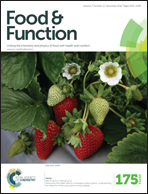The inhibition effect of starch nanoparticles on tyrosinase activity and its mechanism†
Abstract
The objective of the current research was to investigate the effects of starch nanoparticles (SNPs) prepared from waxy maize, potato, normal corn, and tapioca starches on the activity of tyrosinase. As a main polyphenol oxidase, tyrosinase not only induces fruit and vegetable browning but also causes skin diseases by overproducing melanin. Herein, for the first time, we evaluated the inhibitory kinetics of SNPs on tyrosinase. It turned out that SNPs inhibited tyrosinase activity reversibly. The IC50 values of hollow nanoparticles, amylopectin nanoparticles, corn starch nanoparticles, and tapioca starch nanoparticles were 0.308, 0.669, 1.490, and 4.774 μM, respectively. Assay of fluorescence spectra demonstrated that SNPs quenched the tyrosinase intrinsic fluorescence. Moreover, binding constant and binding sites found that SNPs were bound to tyrosinase through van der Waals forces, hydrogen bonds, as well as electrostatic interactions. Analysis of circular dichroism indicated that the incorporation of SNPs into tyrosinase prompted conformational alteration of the enzyme. Furthermore, inhibition of browning by SNPs loading with L-dopa compound indicated that not only the tyrosinase activity was inhibited, but also SNPs decreased free dopa content by adsorption. This research on SNPs as potential inhibitors could give rise to advancement in the realm of anti-tyrosinase and have versatile applications in medicine, food, cosmetics, materials and drugs.


 Please wait while we load your content...
Please wait while we load your content...